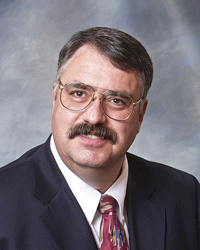 |
BEN BLOYS, Manager, Los Alamos Technology Alliance, Chevron Corp.
|
Chevron continues to be a technology-driven company in the ever-tougher world of deeper water, less conventional reservoir rocks, tighter regulations, and challenging cost management.
Technology advances. Next year should bring our first deepwater well drilled with dual-gradient, mud-lift technology. The new Pacific Santa Ana drillship should soon be fitted with the equipment to allow us to pump mud and drilled cuttings up from the seabed, reducing the hydrostatic pressure on drilled formations, and allowing us to complete deepwater wells with far fewer casing strings. Development of the Enhanced Single-Trip Multi-zone frac-pack system has the potential to substantially reduce completion costs, especially in the Gulf of Mexico’s extensive Lower Tertiary play.
Our technology alliances with Los Alamos National Laboratory and Jet Propulsion Laboratory/NASA continue to yield exciting solutions. Inficomm is a wireless data transmission system that allows real-time pressure and temperature data to be gathered from the bottom of a well without the usual electrical lines or batteries. Sensors for additional physical and chemical properties are in the works. TruDepth gives real-time data on the liquid level in a well, so pumps are never damaged by running dry. Also, keeping a minimal liquid column in the well has reduced backpressure on the reservoir and increased production rates. Safire is a new two-phase flowmeter being commercialized through GE that can be strapped onto any pipe for accurate, real-time oil-cut/water-cut information, even in the presence of gas. These technologies are just the tip of the iceberg, with many more out-of-the box solutions in the works.
Energy efficiency is a continuing focus for Chevron. We’ve reduced our Energy Index by 34% in the last 20 years. Training innovation is front and center, as Chevron continues to address the “big crew-change,” and the thousands of new jobs needed to address booming unconventional plays. Updated curricula, experiential teaching styles, long-distance teaching and more are being implemented by our Upstream Workforce Transformation Group.
Shale plays in the U.S. Chevron’s first entry into U.S. shale plays came with the establishment of the Appalachian/Michigan Business Unit, which has large holdings in the Marcellus, Utica and Antrim shales, both gas and liquids. The other Chevron center for shale activity is the West Texas/eastern New Mexico region, with large holdings in the Wolfcamp, Spraberry, Bone Springs and Avalon plays. Both areas are rapidly evolving with multiple challenges. Shortages of people, equipment and materials create ongoing logistical issues, as well as cost management concerns. Finding sweet spots in unconventional lithologies is slowly becoming less of an art and more of a science. Water management, from sourcing adequate amounts with acceptable quality to recycling and re-use, challenges us just like other operators. We need to work on understanding and reducing formation damage to improve initial production rates and ultimate recoveries.
Chevron’s areas of increased activity in 2013. Australia continues to expand as a major center of activity for Chevron. In addition to the Gorgon and Wheatstone LNG plays, which are well along in development, Chevron has just booked its 16th gas discovery since mid-2009 in the northwestern quadrant of Australia’s territorial waters. The number of LNG trains needed to develop these resources continues to grow, and the area will be a major source of energy for Japan, China and South Korea for multiple decades. Chevron’s long-term developments in Angola and Nigeria will continue, as well as the exploration of newer areas like Liberia and Sierra Leone.
The main focus of Chevron’s shale/unconventional play acquisitions has been outside of the U.S. In 2013, we will try to gain a better understanding of the potential resources in our holdings in Poland, Romania, Bulgaria, China, Canada and Argentina. Every country has unique complications related to logistics, landowner issues, evolving regulations and manpower challenges.
Chevron, the world’s largest producer of geothermal energy, will continue to examine ways to expand its operations in Indonesia and the Philippines, as well as to look for new areas where geothermal can be economic. 
The author
BEN BLOYS is the manager for Chevron’s Technology Alliance with Los Alamos National Laboratories. He also manages Chevron’s R&D program at the Tulsa University Center of Research Excellence. Mr. Bloys has developed technology in a number of areas, including drilling fluids, low-invasion coring, drilling waste management and gas hydrates. He worked for 17 years at the ARCO Technology Center before joining Chevron in 2000. Mr. Bloys holds a BS degree in chemistry from Angelo State University (1983). He has 32 technical publications and 18 patents, and is a member of SPE, AADE, ACS and API. |
|



